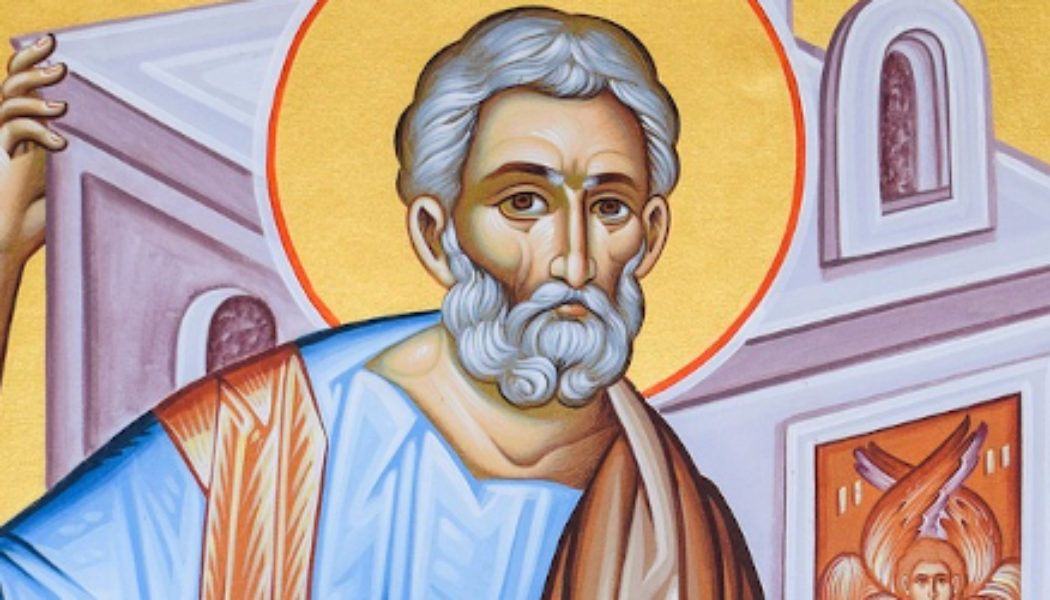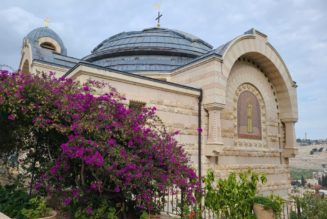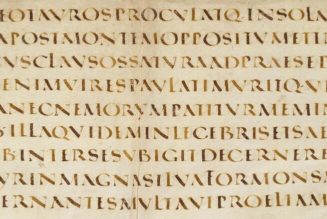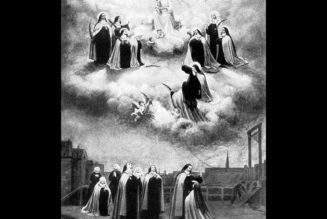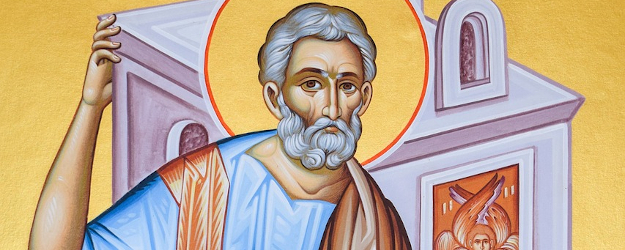 Reading Mark’s Gospel with the Faith of Saint Peter and the Church
Reading Mark’s Gospel with the Faith of Saint Peter and the Church
Saint Peter’s Second Epistle soars the heights of the Spirit akin to the spiritual heights of John’s proclamation of the Gospel (Jn 1:1–14). He whose gift of faith caused Christ to change his name to the “Rock” is no less gifted in spiritual insight and writing than Saint Paul and John the Evangelist. Too often, exegetes have developed a filter through which they hear a Galilean fisherman instead of “Kephas” (Jn 1:42); the one anointed with heavenly wisdom and the prophetic spirit. The wisdom that comes from above is always higher than the knowledge that comes from earthly matters.
Because Mark’s Gospel is the recorded tradition of Saint Peter, and Mark doesn’t seem to emphasize Jesus’s pre-existence as do the other Gospel writers, it is often argued by modern exegetes that Peter has a “lower Christology” than John. Saint John’s Gospel has clearer and more numerous statements from Jesus about his divinity. Nothing is further from the truth concerning Peter. John and Peter both have a “high Christology” if one will consider the internal structure of Mark’s Gospel instead of imposing false 19th-century presuppositions upon the Gospels. Following Peter, Mark proclaims Jesus is the “Son of God” from his very first verse. He does not mean it simply according to the title of Judaic kings of David’s line or in any attenuated sense, but rather in the fullest sense possible since he is writing after the Transfiguration and the Resurrection.
Mark builds up and prepares his reader to understand what Peter’s confession of faith in the Messiah means, just as Jesus built up and prepared Peter to accept its full import by the climactic confirmation and revelation at the Transfiguration. From the opening verse of the Gospel, Mark walks the “hearer” of the Gospel in Peter’s footsteps and experiences: through Jesus casting out demons, healing the sick, forgiving sins (“who but God alone can forgive sins?”), calming the sea, raising the dead, multiplying bread, walking on water, to the climax of his structure of the meaning of “Son of God.” At the climax of the chiastic structure revealed takes place the Transfiguration and the Father’s proclamation: “This is my beloved Son” (Mk 9:7).
It is at the Transfiguration that the meaning of the title “Son of God” from Mark 1:1 is revealed, a meaning which requires faith to accept. Jesus is God the Son because he is divine and is the presence of God on earth, God with us (cf. Mt 1:23). God the Father confirms Peter’s earlier confession and reveals its content: Jesus is no mere man simply born of woman, he is God come to his people in the flesh. The confessed Messiah is more than a man. The light of glory shining from Jesus at the Transfiguration reveals his Divine Nature; “the divine nature” Peter will later confirm in his Second Letter, the divine nature in which humans can now participate through faith in the Son of God (see 2 Pet 1:3–4). Peter’s suspicion after Jesus walked on the water, the astonishment by which he believed him to be more than human (cf. Mk 6:52) and confessed him Messiah (Mk 8:29), is explained in the Transfiguration. Jesus radiates the divine glory and brings the glory cloud of God at his manifestation because Jesus is God.
Multiple scholars have demonstrated and confirmed that the Transfiguration is the dead center of Mark’s Gospel in the beautiful chiastic structure which defines it.1 The structure is intrinsic to the written proclamation and defines the context and meaning of the title “Son of God.” Not recognizing the structure, how could these scholars accurately assess Peter’s grasp of the Transfiguration in Mark’s Gospel? It was in the Transfiguration that Jesus revealed his Sonship was not by adoption but generation from eternity; that “Son of God” meant birth from eternity before the world was created. Peter expresses his understanding more clearly in his Second Letter, yet, these same scholars will not accept that Peter is in fact the author of that letter which internally and repeatedly claims to be written by him (cf. 2 Pet 1:1,12–15; 3:1–2). Such false a priori methodological approaches which deny Peter’s authorship are rightly referred to by some scholars as “operating out of a squirrel cage” and running around in circles to avoid the obvious conclusion which Mark wishes the reader and hearer to grasp. The early Church accepted Peter’s Second Letter as originating with him and any doubts to the contrary are easily resolved with responsible considerations.2
Hopefully it is only heart-warming homilies — appealing to Peter’s weaknesses and fumbles — which have distracted exegetes from perceiving his infused and “prophetic word” (cf. 2 Pet 1:19) derived from the Transfiguration’s significance. If we do not have Peter’s mature faith in Christ (cf. Eph 4:13; Mt 16:16), then we will be led astray on the waves of false doctrine by the cunning of men (cf. Eph 4:14; 2 Pet 2:1–22). Peter is clear that he expects his readers of the Second Letter to be “those who have obtained a faith of equal standing with ours in the righteousness of our God and Savior Jesus Christ” (2 Pet 1:1).
If one does not believe that Peter accepted Jesus as God (in the sense the Council of Nicaea summarized his faith), then one will do a lot of “squirrel cage” exegesis in trying to explain Peter’s letters and Mark’s Gospel. Such a lack of acceptance of Peter’s true faith could contribute to why many modern scholars doubt Peter’s authorship and push for a late second generation dating of Second Peter; they do not realize that for Peter (and so for Mark) the Transfiguration has always been the proclamation that Jesus is God, the Son. It is John’s Gospel that verifies this.
Together at the Transfiguration: Insights from John’s Faith, which Is Peter’s Faith
Both Peter’s Second Letter and John’s Gospel open with an exegesis of the spiritual and theological significance of the Transfiguration. This bears repeating: John and Peter both open with the Transfiguration in the very first chapter of their last testimonies (John at 1:14b and Peter at 1:16–18). This should surprise no one upon considering they were the only two surviving eyewitnesses of the event. Two or three are needed to testify to what took place in secret and so they fulfil the law’s requirement just before they died. John’s Gospel and Peter’s Second Letter are their last writings and a testimony to what only they could verify after the Resurrection and for the sake of posterity: “Jesus charged them to tell no one what they had seen, until the Son of man should have risen from the dead” (Mk 9:9). Having risen from the dead, the same Apostles made the Transfiguration central to their proclamation of Christ.
Following Jesus’s “charge” as related by the Synoptics, John’s Gospel constantly points to the meaning of the Transfiguration. Joseph Raya reminds readers, “John saw all the events of Christ not only as historical, but also as theological.” Authors of the Eastern tradition rightly present John’s Gospel as an entire theological reflection of the Transfiguration with all of John’s passages about “glory.”3 It has been argued that John does not include an institution narrative, unlike the synoptic accounts, as his entire Bread of Life discourse in his chapter 6 serves as an explanation of the Last Supper. In the same way, John does not include a narrative of the Transfiguration because chapter 1 verses 1 to 14 are the spiritual and theological explanation of what was already related in the Synoptics. For John, Jesus is able to reveal the glory of God because Jesus is God. He is God the Word, coming from the Father from all eternity as light comes from light . . . generated from mind (spirit) as Logos is in Eternal Mind (Spirit).
It is hard to miss that for John, the light of God’s glory coming from Christ emanates because Jesus is God, the Word made flesh. In the prologue of John, the word “light” (and “enlightens”) appears seven times. In essence, John demonstrates that the Word, through whom the world was made (1:3) was bringing forth a new creation and entrance to the eternal kingdom (cf. 2 Pet 1:11) through his humanity. John 1:14 concludes and testifies that “we have beheld his glory, glory as of the only begotten Son from the Father.” The Transfiguration was thus a manifestation of the truth of Christ’s origin from eternity as the bearer of eternal life. The dawn from on high had broken upon us (cf. Lk 1:78; Ps 110:3). Reference in John 1:29 to “the next day,” implies that 1:14 operates as the first day of the new creation and breaking forth of God’s kingdom.4
Peter’s Focus in the Second Letter
In his Second Epistle, Peter focuses upon the questions with which every generation of Christians (and their detractors) must wrestle . . . are you sure you correctly understand Jesus’s message and identity? Where is the promise of his coming? (3:4). Peter summarizes the Christian kerygma, the call to participation in the divine nature (1:4); the call to daily conversion to grow into the gift that was received (1:5–10) so as to enter the eternal kingdom (1:11); assuring us that we are not following cleverly devised myths (1:16); and recalling the Transfiguration (1:16–18). In what seems a sudden shift – but which is Peter establishing his main point — he tells us that no prophecy of Scripture is a matter of one’s own interpretation, because no prophecy ever came by the impulse of man (1:20–21). Towards what prophecy of Scripture is he pointing? For Peter, clarifying this “prophecy of Scripture” is the main focus of his Second Letter. Depending on how one dates the New Testament writings and the meaning of “prophecy” and “scripture” in that verse, affects the accuracy of a commentary on Second Peter.
Regarding the Transfiguration, and precisely as an eye witness, Peter establishes that he saw and heard no myth (2 Pet 1:16). Peter has thus provided his readers with an explanation of his faith in the divinity of Christ who is the source of eternal life. Christ’s divine nature was not only revealed in the Transfiguration (2 Pet 1:4, 16), it was confirmed in the Father’s declaration (2 Pet 1:17; Mk 9:7) . For Peter, and by his order of presentation, the Transfiguration becomes the proof that his discussion of verses 3–11, of becoming a participant in the divine nature, is certain, true, and efficaciously taking place in the souls of those who believe. This is the central proclamation of the faith (kerygma) of the Church which Peter wishes to leave in writing before he dies (v. 12–15). An entire summary of the faith is thus being bequeathed to the Church in his final testimony: Peter begins by speaking of how we can become “participants in the divine nature” (v. 3–4) (implicitly through Christ who is God), and how we must use our freedom (v. 5) to make this spiritual and eternal kingdom more internal to us (v. 5–11) through choices (the moral life) which faith in Christ (v. 3) empowers believers to secure (the same light of the transfiguration in themselves which is eternal life).
For Peter, the Transfiguration is both a real historical and mystical event that entered our world (as eye-witnessed by Peter, James, and John) and also a confirmation of things to come. For this reason, it is prophetic (v. 19) or “prophecy” (v. 20) based on how it helps Christians to interpret Christ’s prediction when Christ spoke of “some not tasting death before seeing the kingdom of God come with power” (Mk 9:1). This is why immediately after speaking of the Transfiguration Saint Peter then begins discussing the interpretation of prophecy (v. 19–21). Peter’s whole Second Letter is centered upon confirming the whole Christian message in view of the Transfiguration, in order to explain the prophecy of Christ which occurs right before the Transfiguration in each of the Synoptic Gospels. The “prophecy” (v. 19–21) about which Peter speaks must be Christ’s prophecy related by the three Evangelists Matthew (16:28), Mark (9:1), and Luke (9:27). In summary they state: “There are some standing here who will not taste death before they see the kingdom of God” (Lk 9:27). Mark will record: “the kingdom of God come with power.” Matthew, the first witness in the written record, will say: “Son of man coming in his kingdom.”
It is concerning this prophecy of Christ’s coming that Peter’s Second Letter is dedicated to addressing and explaining. It is this prophecy that all the Synoptics clearly tied to a preliminary fulfillment in the Transfiguration by their structures. Peter’s Second Letter is written to strengthen all the faithful for Peter’s imminent death and is a testimony against the false teachers who are arising and using the prophecy of Christ’s coming to mock Christ and Christians; those who miss the letter’s ties to the meaning of the Transfiguration and Christ’s plan to redeem not only Israel, but the whole human race in Adam. Afterall, if Peter is about to die, and Christ said, “There are some standing here who will not taste death before they see the Son of man coming in his kingdom,” then perhaps the Gospel writers and their followers misunderstood Jesus’s identity? To be more concise, the question is similar to contemporary exegetes whose false and anachronistic presuppositions lead them to such doubts and publication of doubts in both subtle and plain statements.
New Doubts Are Same as the Old Doubts
More recently, the doubt comes in the form of an assertion similar to those raised by historical-critical method exegetes (practicing form criticism) beginning around the 19th century. Some of these exegetes do not accept that the Apostles understood Jesus to be God. Working from presuppositions that oftentimes methodologically exclude the supernatural,5 and falsely asserting it took decades before the Apostolic community ever asserted Jesus was God, their doubt runs something like this: “Based on Jesus’s prediction about some not tasting death before the coming of his Kingdom, Jesus and the Apostles believed Christ’s return in glory [Second or Final Coming] would be during the lifetimes of the Apostles.” More simply, and faithlessly, Jesus was incorrect and clearly never meant for folks to think of him as God. Twenty centuries later, whoops! It may have been an overzealous misunderstanding by them all!6 All the more reason for such exegetes to posit falsely that the New Testament writings now in the canon were by second generation Christians who “Hellenized” Jesus’s claims contrary to the intentions of his words and Jewish culture.
In 1964, the Pontifical Biblical Commission gave a sound warning on misuse and limits of such methodology:
For certain exponents of this method, led astray by rationalistic prejudices, refuse to admit that there exists a supernatural order, or that a personal God intervenes in the world by revelation properly so called, or that miracles and prophecies are possible and have actually occurred. There are others who have as their starting-point a wrong notion of faith, taking it that faith is indifferent to historical truth, and is indeed incompatible with it. Others practically deny a priori the historical value and character of the documents of revelation. Others finally there are who on the one hand underestimate the authority which the Apostles had as witnesses of Christ, and the office and influence which they wielded in the primitive community, whilst on the other hand they overestimate the creative capacity of the community itself. All these aberrations are not only opposed to Catholic doctrine, but are also devoid of any scientific foundation, and are foreign to the genuine principles of the historical method.7
Coupled with a growing loss in the West of the early Christian doctrine of deification, and exacerbated by German Lutheran scholars of the 19th century (extrinsicists in matters of grace and the Spirit; and lacking appreciation for the lex orandi, lex credendi of Tradition), exegesis only became more confused when the Catholic sola historical-critical crowd of the ’70s to ’90s built upon all the anachronisms and false presuppositions of the previous German scholarship. Some Catholic scholars of recent decades not only wondered if Jesus understood his prophecies, but others even questioned if the Apostles were aware of things like the Virgin Birth as anything more than a literary device.8
Saint Peter is clear, “since I know the putting off of my body will be soon, as our Lord Jesus Christ showed me . . . I will see to it that after my departure you may be able at any time to recall these things” (1:14–15). What things? Peter wants them to remember the correct way to interpret the record of the Transfiguration as the manifestation of the present and the future Kingdom. It was a real historical coming of God’s glory (kingdom) and it held prophetic significance as a prophetic event and word of promise. Peter’s point is to confirm that before he dies, the event and vision of the coming Kingdom was already seen in advance by James, John, and himself before Christ’s death.9 He has already seen it before he dies! (cf. 2 Pet 1:16 and John 1:14). It has been fulfilled at least once in down payment form and will be fulfilled again in an ultimate coming.10 Thus the Transfiguration is a “prophetic word made more sure” (2 Pet 1:19) since it is a downpayment.
People should not listen to false teachers (2 Pet 2:1) who misrepresent the meaning of Jesus’s words (or prophecy) and the vision that immediately followed of the Transfiguration; the vision of real mystical events that momentarily transformed the historical environment and which immediately followed Jesus’s prophecy of his “coming in power”. The Transfiguration was a down payment, a guarantee or ἀρραβῶνα (cf. 2 Cor 1:22), on Jesus’s prophecy and promised coming. It has immediate concern for Jerusalem and secondarily a future meaning (vision) for the whole world.
The Transfiguration Is a Pledge (Arrabona) and the Kingdom Is the Spirit
This is why Peter talks about “prophecy of Scripture” (1:20) after speaking of his being an eyewitness of Jesus’s majesty (power and coming) (2 Pet 1:16) at the Transfiguration. The prophecy of coming in His kingdom has had a minimal fulfillment already and serves as a pledge (ἀρραβῶνα) of the ultimate fulfillment to come. Peter is using the Transfiguration event to confirm and summarize the heart of the Gospel: Jesus is God by nature, but not the Father; and, we are called to participation in the divine nature (1:4) through the humanity of Christ (especially sacramentally).
The Transfiguration revealed that Jesus’s humanity is in the fullness of divinity (the eternal Kingdom) (1:16). Jesus’s human nature — his “flesh”, in which he became man — is the means of entrance into the eternal kingdom (2 Pet 1:11; cf. Heb 10; Jn 1:14). Jesus’s kingdom is already here in its beginnings (the giving of the Spirit per 2 Cor 1:22). Now we must “grow in the grace and knowledge of our Lord” (2 Pet 3:18; cf. Eph 4:13–15) and ourselves “be swallowed in divinity” (cf. 2 Cor 5:4, 4:17) . . . the divinity Christ has brought at his incarnation and revealed in the Transfiguration.
Just as the Spirit is an ἀρραβῶνα already in our hearts (“he has put his seal upon us and given us his Spirit in our hearts as a guarantee [ἀρραβῶνα]” [2 Cor 1:22]), something already ontologically begun and active in our souls, so the Transfiguration is the ἀρραβῶνα of Jesus’s Second Coming in glory and majesty. The difficulty for many exegetes is that their presuppositions — for example, that belief in Christ’s divinity as a later development of second generation Christians, and the corollary that the Apostles were thereby not the actual authors of what is attributed to them — prevent them from drawing forth the obvious meaning of the Transfiguration for the Apostles. Paul’s intrinsicist approach to grace (cf. 2 Cor 13:5; 2 Tim 1:14) would make no sense unless the earliest Christians already believed Christ could give eternal life because he possessed it in himself.
The Kingdom is not only a future reality for early Christians, it is the eternal life and divinity that Christ has brought in becoming man because he is “the eternal life” (1 Jn 1:3) and already granted humanity a share in this life (“he has put his seal upon us and given us his Spirit in our hearts as a guarantee [ἀρραβῶνα]” (2 Cor 1:22). The Kingdom walked in our midst and continues among us in his physical resurrection from the dead and Ascension. For this reason, instead of praying “Thy Kingdom come,” in the Lord’s Prayer, many early Christians often instead prayed, “Thy Spirit come” or “Thy Spirit come and purify us.” Saint Gregory Nyssa says, “the holy Spirit is the Kingdom” [“ ”]!11 This exchange of words was prayed in recognition of one’s ongoing sanctification (deification) and transformation in Christ . . . the eternal kingdom (2 Pet 1:11); the very reason we must make every effort (v. 5) to enter Jesus more fully . . . having received the Spirit to flourish and enter true happiness.
Peter and John knew that some people were already misrepresenting the mystery of the Church. They were misrepresenting the relationship between Jesus’s prophecy of his coming in glory and the Transfiguration scene that followed the prophecy in all the Synoptics. The loss of faith from such exegesis today is also leading many Christians back into licentiousness, returning to their former ways as dogs who return to their vomit (2 Pet 2:22). Apparently, the more things change, the more they stay the same. For this reason, Peter gives a correction to the scoffers (3:3) who ask where is the promise of his coming? He reminds them and believers that this growth of the kingdom and spread throughout the world has already begun, but may take thousands of years before Jesus’s ultimate return in glory. He reminds them of his first letter (3:1), that the kingdom, that extension of Christ in the world, that Temple (cf. 1 Pet 2:1–10; Dan 2:35b) is still being completed. In response to the scoffers and to strengthen believers to not despair after his death, Peter records to posterity: “But do not ignore this fact, beloved, that with the Lord one day is as a thousand years, and a thousand years as one day. The Lord is not slow about his promise as some count slowness, but is forbearing towards you” (2 Pet 3:8–9).
Peter’s Second Epistle begins by exploring the implications of the meaning of the Transfiguration as relates to our sharing in Jesus’s divine nature (1:4), the kingdom we enter through faith in Jesus as God’s Son, our call to transfiguration in Christ under the Spirit by living the truth in love (1:5–11), and the Lord’s “coming” and “prophecy” of return in glory (v. 16–21). Peter ends the letter by explaining that the prophecy must be understood within the context of giving the world a chance for repentance (which includes ongoing sanctification, inclusive of repentance): “The Lord is not slow about his promise [prophecy of his coming] as some count slowness but is forbearing toward you, not wishing that any should perish, but that all should reach repentance” (2 Pet 3:9).
Central to his clarification on timeframe is that it is not for false exegetes (false prophets) to explain the meaning of the prophecy contrary to his experience: “No prophecy of Scripture is a matter of one’s own interpretation, because no prophecy ever came by the impulse of man” (1:20–21). As the prince of the Apostles, to whom even Paul’s letters are subject to Peter’s interpretation, the reader is reminded: “And we [the eyewitnesses of the Transfiguration and prophecy] have the prophetic word made more sure. You will do well to pay attention to this as to a lamp shining in a dark place, until the day dawns and morning star rises in your hearts [the light of Christ transfigures your life and you grow more into Him]” (1:19).
2 Peter 3:16 Gives the Authoritative Interpretation of 1 Thessalonians 4:21
Central to Peter’s point about prophecy, Peter ends his Second Letter with reference to Saint Paul’s writings (cf. 2 Pet 3:15–16) concerning Christ’s plan for the kingdom and especially Paul’s writings on Christ’s ultimate return. Peter is undoubtably familiar with Paul’s themes of the growth of the Church as portrayed in Ephesians 4 and the mystery of one’s incorporation into Christ. Peter’s discussion in his very first letter of believers as “spiritual stones” (1 Pet 1:5–9) being built in to the true Temple is the same theme of Paul’s “mystical body” language. Certainly, Peter would know the “spiritual stone” imagery meanings in relationship to Daniel 2:35b, a Mountain or temple that must eventually cover the whole earth. Surely, he understood why Christ changed his own name from Simon to “Kephas” (Jn 1:42), the Rock . . . the foundation inside Christ upon which the Mountain of the Lord shall expand.
More importantly, by the fact that Peter mentions Saint Paul at the end of the letter, he seems to be correcting a misappropriation of Paul’s First Letter to the Thessalonians, maybe even misappropriations of it by the Corinthians just before Paul’s death (cf. 2 Tim 1:18). Based on the word “coming,” the prophecy of Saint Paul to the Thessalonians is probably the whole reason Saint Peter is having to write his Second Letter, and warn that “no prophecy of Scripture is a matter of one’s own interpretation” (2 Pet 1:20) and ending the letter warning about how Paul’s letters “are hard to understand, which the ignorant and unstable twist to their own destruction as they do the other Scriptures” (3:15–16); hereby, also demonstrating that Paul’s letters were considered Scripture and prophetic.
Since Ephesians 4:11 lists New Testament ministries of “apostles, some prophets [bold mine], some evangelists, some pastors and teachers” one should not limit Peter’s mention of “prophecy” to Old Testament prophets; especially when Paul presents himself as one chosen in the tradition of the prophets (cf. Gal 1:15) and since the “apostles” are superior to prophets. This is why the writings of the Evangelists and Paul are being included and referred to as “Scripture” (2 Pet 3:16) as well. Peter clearly sees his writings and Paul’s writings, and the Gospels already written, as “Scripture.” As this essay mentioned earlier, how one dates the New Testament writings affects how one interprets “scripture” and “prophecy” in Peter’s Second Letter. It affects one’s entire exegesis.
To verify that Peter’s Second Letter is alluding to First Thessalonians, when Peter mentions Paul, the Textus Receptus is needed. There are only three times when the Greek word παρουσίαν (in the accusative feminine singular form)12 is used in Scripture. In these instances, παρουσίαν is translated as “coming” and transliterated as parousian, as in “the Parousia of the Lord.” It first appears in Saint Paul at 1 Thessalonians 4:15: “For this we declare to you by the word of the Lord, that we who are alive, who are left until the coming [παρουσίαν] of the Lord, shall not precede those who have fallen asleep.” Lastly, the remaining two uses of that particular form appear only in Second Peter: “We did not follow cleverly devised myths when we made known to you the power and coming [παρουσίαν] of our Lord Jesus Christ, but we were eyewitnesses of his majesty” (1:16); and, “waiting for and hastening the coming [παρουσίαν] of the day of God, because of which the heavens will be kindled and dissolved, and the elements will melt with fire!” (3:12). Parousian, or more commonly Parousia, does not limit itself to mean only one “coming” of the Lord, but entails multiple advents of the Lord since παρουσία can mean: presence, coming, arrival, or advent (repeated visit).13
For Peter, “the coming” minimally refers to the Transfiguration and a later worldwide event. The only two times Peter uses Parousia in the accusative feminine singular form, it makes clear that the coming of Jesus is the “coming of the day of God,” the day of judgment and the vindication of Christ and his promises. Since Peter uses the term in this way, both for the Transfiguration (when the Kingdom was revealed as already possessed by Jesus on earth) and for a warning of coming judgments, then it would seem that for Peter there were at least 3 times when there was or would be a “coming” (Parousia) of the Lord. The three times would be: the Transfiguration just before entering Jerusalem for the New Exodus, the promised destruction/judgment of Jerusalem for rejecting the Messiah’s entrance (cf. Mt 21:18—24:3, particularly 21:41), and the end of the world when the New Covenant people experience the great apostasy of which Paul gives further explanation in his Second Letter to the Thessalonians. One way or the other, the Transfiguration, the truth that Jesus is the bearer of the kingdom and the doorway of it, remains the key for understanding all the “comings” (Parousia) of the Lord.
With this in mind, and help from Romano Guardini, the last half of this essay will attempt to relate the meaning of the Transfiguration to the destruction of Jerusalem in 70 AD and the approaching end of the “time of the Gentiles” (Lk 21:24) of which Jerusalem in 70 AD is the sign and prophecy.
Guardini’s Fixed Limits: Judgment of Jerusalem, the Mountain of the Lord, and Judgment of the World
Through the Spirit, Peter has confirmed the faith of his brethren in his final recorded words in Scripture which are “the prophetic word made more sure” (2 Pet 1:19). It is a summary and symbolon. While the timing of Jesus’s Second Coming is a mystery, the Spirit has continued to bring the Church to understand (cf. Jn 14:26; 16:13) and grow into the teachings of Saints Peter and Paul as the faith spread throughout the world in its many inculturations. It is one thing for the Apostles’ to have understood the prophecy of the Second Coming and ardently hoped for it, it is another for Christians all throughout the world still awaiting Jesus’s ultimate coming: “to attain to the unity of the faith and of the knowledge of the Son of God, to mature manhood, to the measure of the stature of the fulness of Christ . . . growing up in every way into him who is the head” (cf. Eph 4:13–15).
Paul is clear that the plan of Christ was not only for the Jews, but for the Gentiles as well: “God set me apart before I was born . . . called me through his grace, was pleased to reveal his Son to me in order that I might preach him among the Gentiles” (Gal 1:15–16). Christ also prophesized that the nation of Israel would reject him (in the leadership of the Sanhedrin, cf. Mk 8:31; 9:31) and that the Mountain of the Lord would be thrown down into the sea of the Gentiles (cf. Mt 21:21, 41)14 due to the rejection and oppression of the leadership (Mt 21:41). “Israel will be trodden down by the Gentiles until the times of the Gentiles are fulfilled” (Lk 21:24). Israel was ripe for judgment because they were the only “world,” the only peoples, that knew to look for the Messiah based on specific promises made to their Fathers. The whole nation, represented by the Mountain of the Temple (cf. Is 2:2), the Law of Moses and its practices, existed to bring the Messiah into the world, and once that city of God began to live in set rejection of the Messiah’s entrance, it became an obstacle to God’s plan for humanity;15 the plan to build the true temple of the Messianic age (cf. Is 2:2–4), the mystical temple of Jesus’s body, the Church (cf. Jn 4:21).
Jesus’s Transfiguration was a confirmation and proof to his Jewish followers that he was the Messiah and the fulness of the promised eternal life and kingdom. After the Resurrection, Peter, James, and John publicly testified to it as both reality (present now by the Spirit) and prophetic (still developing) as they performed Jesus’s very works in the midst of Israel. The Transfiguration was the down payment (guarantee, cf. 2 Cor 1:22) of Christ’s promised return in glory for the rest of the world, but first the temple and rites which were only a preparation for the Messiah would have to be removed by the same God who had it built. “Believe me, the hour is coming when neither on this mountain nor in Jerusalem will you worship the Father” (Jn 4:21). Before his ultimate return for the rest of the world, the time of the Gentiles, the Gospel would have to create a new Temple that covers the whole world (Dan 2:35b, 44) and the people of that Messianic Temple would await Jesus’s ultimate return as they were being sanctified and finishing the fulness of Christ’s body. The nation of Jacob (cf. Gen 28:10–15) built the first temple to prepare the Jews for God one day ultimately joining heaven and earth and reuniting humanity in a new Adam, the Son of David. This promise was ultimately revealed and fulfilled in Jesus’s Transfiguration and the Resurrection which established the new Messianic age and temple forever.
Heaven and earth were joined in the Christ. Through the Incarnation, God the Logos tabernacled by becoming man (Jn 1:14). Often we read, “became flesh and dwelt among us,” but the Greek of John’s Gospel presents the Incarnation as revealing that the glory cloud of Mount Sinai (cf. Ex 19–24) had become the very reality and presence of Jesus; the coming into being of a new and permanent holy of holies for God’s people to enter. Thus the “dwelt among us” used the Greek verb for “pitching a tent” to explain the new place of God’s intimate dwelling among men.16 This tabernacled presence covers the whole earth (cf. Dan 2:35b) wherever the apostolic successors make present the lamb of God under the appearance of bread and wine, making men “partakers of the Holy Spirit . . . and the powers of the age to come”(Heb 6:4–5; cf. 1 Cor 5:7–8; Rev 14:1); having been “enlightened” (Heb 6:4) by “the true light which enlightens every man” (Jn 1:9) and whose glory was manifested and “beheld” in the Transfiguration (Jn 1:14b; 2 Pet 1:16–17).
In its governing body, Israel officially rejected God’s ways and God’s Kingdom (cf. Dt 18:18–19) when the high priest and Sanhedrin condemned Jesus to death after Jesus made clear he was the Messiah, the Son of God (Mk 14:62). They saw Jesus’s miracles, they confirmed the healing of every leper he cleansed and sent to them, they knew of his multiplication of loaves, raising of the dead and casting out demons, but instead they chose a priesthood of exclusion (Levitical) of others from God’s household instead of the inclusion God originally desired (cf. Ex 19:5–6; 1 Pet 2:5) before Israel showed itself faithless and broke their side of God’s covenant (Ex 32:29; Jer 31:32). Jesus came to bring to completion the reign of God, but instead of rejoicing at the new covenant (Jer 31:31) and their brethren having the Holy of Holies reopened to them (Heb 10:19–20), the wedding guests killed the bridegroom, “the heir” (Mt 21:38; 22:6). For this reason, God, “the king was angry, and he sent his troops and destroyed those murderers and burned their city” (Mt 22:7). A corrupted leadership brought suffering on the innocent masses by their continued apostasy.
The Old Testament world ended and was destroyed because the only “world” that was awaiting the Christ (Jerusalem and its people) had ultimately apostasized through the leaders. God used the Romans as his instrument of justice to break the earthly Temple. It was a temple made by human hands and so could be destroyed by human hands. Ironically the leadership preferred the temple built by human hands over the rock which “was cut out by no human hand” in the Virgin Birth (cf. Dan 2:34; Lk 1:34–35). In seeking to destroy Jesus to save their earthly temple, they lost both what they sought to protect and a much greater Temple. Since even after his death and resurrection, the leadership would not accept the sacrifice of Christ, God ended the sacrifices with the destruction of the temple (the sacrifices which were added only due to transgressions of the Law, cf. Gal 3:19).
The Temple and Levitical priesthood that served it had become an idol and brought the Levites to the point of murdering the Messiah in order to cling to their way of life instead of the promises of God. The Jews had fought hard “with superhuman courage and tenacity” to surrender their all and their lives to God in fighting to preserve the Sabbath and Temple rites from oppressors, but in the process they displaced the promises of God for the earthly Temple and for the prescribed sacrifices.17 It was the Israelites who sinned at Sinai, not the rest of the nations, so why should the nations sacrifice and live according to rites only increased and added for Israel’s transgressions (cf. Gal 3:19) of the Law if the Messiah brought what God really intended (Ex 19:5; 1 Pet 2:9)?
The end of the Old Testament world came about when it failed to accept the promised Son of God, when its resistance to him “passed its fixed limit.” This insight of Romano Guardini (in The Lord) about fixed limits and the destruction of Jerusalem and later the whole world, gives us greater insight into the meaning of the Transfiguration as both an event and pledge of Christ’s promised coming. We must recognize in the structures of the synoptic Gospels, the Transfiguration is a confirmation to Jesus’s disciples of Jesus’s messiahship before he testifies to it under oath to the high priest. The Transfiguration occurs as the climax of Peter’s Gospel in the chiastic structure as recorded in Mark’s telling.18 Soon thereafter, knowing the leadership will reject him, Jesus prophesies the coming destruction of Jerusalem, and the Synoptics simultaneously record him speaking in terms of the end of the world. However, the destruction of Jerusalem and the description of the Second Coming must be distinct events (even when they seem blended together). Otherwise, how could the destruction of Jerusalem be the handing over of the vineyard (Mt 21:41) to other tenants at its destruction (Mt 22:7) if they are not distinct events?
Using the term Parousia in Second Peter — and Peter’s confirmation that one Parousia has already happened at the Transfiguration, and one is still to be expected — shows how the Transfiguration is both a historical and real pledge of the coming replacement of Jerusalem with the Messiah’s Kingdom (cf. Jn 4:21) and how the final Parousia will come when the time of the Gentiles is fulfilled. The time of the Levites (the custodians, cf. Gal 3:19–24) ended with the Advent (Parousia) of Christ’s priesthood, the higher priesthood that is according to the order of Melchizedek (Ps 110), when the dawn from on high (Lk 1:78) was revealed in the Transfiguration and the declaration made: “This is my beloved Son, with whom I am well pleased” (2 Pet 1:17). Per Psalm 110, Christ was the true High Priest and had the right to purify and renew the Temple and all its practices by his priesthood.19 In showing the Kingdom at the Transfiguration, he was showing the new Priesthood, and the new entrance into the true Temple/tabernacle (cf. Heb 10:19–21) which the Eucharist would make possible. The old had been made obsolete at the Transfiguration, the fulness of time for those awaiting the Messiah’s kingdom was fulfilled. Judgment had arrived.
Romano Guardini concisely explains how everything centers on faith in Christ: “There stands the poor Rabbi from Nazareth who in a few days will be arrested, and says: The city will be destroyed! The world will be destroyed! And both because you have failed to accept the Son of God! The world will come to an end when your resistance to him has passed its fixed limit, and the measure of divine wrath is full.”20 Just as Israel was destroyed because it was the Mountain of the Lord but had turned the things of preparation into idols, becoming an obstacle to the Messiah, so the New Covenant people of the Lord will end with Jesus’s return in Glory. However, their world could not be judged yet because it was not awaiting him to the ends of the earth. The Old Covenant had just introduced him to the world and surrendered him to the Gentiles. The end for the Gentiles and the whole world will come when the full number of Gentiles and Jews enter the spreading new Mountain of the Lord (participation through the Spirit in Jesus’s Resurrected and Ascended body in the Eucharist) in communion with and through the faith of Saint Peter the Rock.
As the Old Covenant came to an end when the leaders and teachers led the people irreversibly astray, so the time of the Gentiles will not end before the leaders of the new covenant become in the words of Saint Peter: “waterless springs . . . entice with licentious passions . . . slaves of corruption . . . last state worse than the first” (cf. 2 Pet 2:1–18). Until the New Israel, the New Covenant has covered the earth and then that leadership becomes a barrier to people living faithfully to the Covenant, the end will not come. Once the New Covenant people (still bringing in both Jew and Gentile into the Mystical Body) fall into the great apostasy (cf. 2 Thes 2:3) and ‘fixedly’ trade Jesus for the spirit of the age, then the end will come for them as well. They will have reached their fixed limit.
Transfiguration and the Prophecy of Coming Judgment
For this reason, the Transfiguration as a pledge and explanation of the “prophecy” of Jesus’s “coming” seems to foretell two judgments. First, by revealing himself to the Apostles in the Transfiguration, Jesus shows the Jews that their expected Messiah has already arrived and brings the kingdom of God in himself. The death and resurrection of the Lamb opened up a New Exodus. His Resurrection and empty tomb; his Ascension before 500 and the outpouring of the Holy Spirit; the miracles of his Apostles and the witness of their miracles by the Sanhedrin are testimony that Jesus is the Messiah, he is the rock upon which those who oppose him will be broken. Jesus offered himself and his reign to all Israel but he was rejected repeatedly by the only “world” (nation) then expecting his coming.
God waited patiently for 40 years, but Israel did not repent of killing the Messiah and so it was destroyed by the Romans; a people ignorant of God’s providence and that the gods of their capitol would be defeated by the Messiah. That day of the Lord, that Advent or Parousia, that coming of God (cf. Mal 4:1), brought an end to all sacrifice as prescribed by Moses. Some to whom Jesus prophesied his Parousia were in fact alive in 70 AD to see not only his Transfiguration and Resurrection, but the ending of that world (Jerusalem and the rites of the temple). However, the sacrifice Malachi promised (the true vineyard of the Lord) still continues as the pure offering among the nations (Mal 1:11) where the Covenant of the Messiah continues and the Mountain of the Lord has spread in the Eucharistic sacrifice of Jesus the Christ.
Showing his kingdom and power in the Transfiguration, Jesus secondarily is showing the whole world how it will end once it receives the truth that makes men free. Freedom was meant to be used for goodness and true development, not an excuse for evil. Since the fall of Jerusalem, all the world has had the chance to perceive the truth about God and man, to experience freedom; the whole world knows to expect Jesus’s ultimate coming, and yet today many seem to be reverting to scoffers. When the scoffers overcome the faith of Saint Peter inside the visible household of God, we will not want to be found among those not laboring in the vineyard, and not distributing the faith as good stewards (cf. Mt 24:45–51).
Christianity has spread throughout the whole world (only more recently the Western Hemisphere with Columbus and the appearance of Our Lady of Guadalupe calling all to Christ). Having shown his coming to Peter, James, and John and confirmed it by his Resurrection and Ascension, the Transfiguration lets us know that the same judgment that befell Israel at its visitation by the Son of God will also befall the whole world upon Christ’s Second Coming (cf. Lk 19:44). In the Transfiguration (Mt 17), Jesus brought down the same cloud of glory to Tabor that had descended on Mount Sinai in fire (Ex 19–24), the cloud in which heaven came to earth riding upon the activity of the angels. Jesus will do the same before everyone when the rejection of him, the rejection of goodness and love reach their “fixed limit”; when his Church throughout the whole world apostasizes (cf. 2 Thes 2:3), then time will have reached its telos and time will end.
Peter saw this vision of the end of time breaking into our world at the Transfiguration, when the surroundings around him atop Tabor seemed to be replaced by bright light and melted away into momentarily seeing what is always around Jesus and in Jesus, namely the Kingdom. Perhaps in describing the end of time he is describing something of what he saw and what is to come, the once, the present, and the future kingdom: “the heavens will pass away . . . the elements will melt with fire!” (2 Pet 3:10). As it was true for those Israelites of Jerusalem hearing of the Transfiguration before 70 AD, it will also be true for Gentiles who read Jesus’s promise to return in glory — they too will not taste death before seeing the Son of man coming with the clouds of heaven. Peter saw it and reconfirmed its first fulfillment in his last testimony, his Second Letter. The Transfiguration is an ἀρραβῶνα . . . a pledge. The whole world will one day see Jesus’s Parousia, guaranteed! Maranatha!21
<!–
–>
Services Marketplace – Listings, Bookings & Reviews
